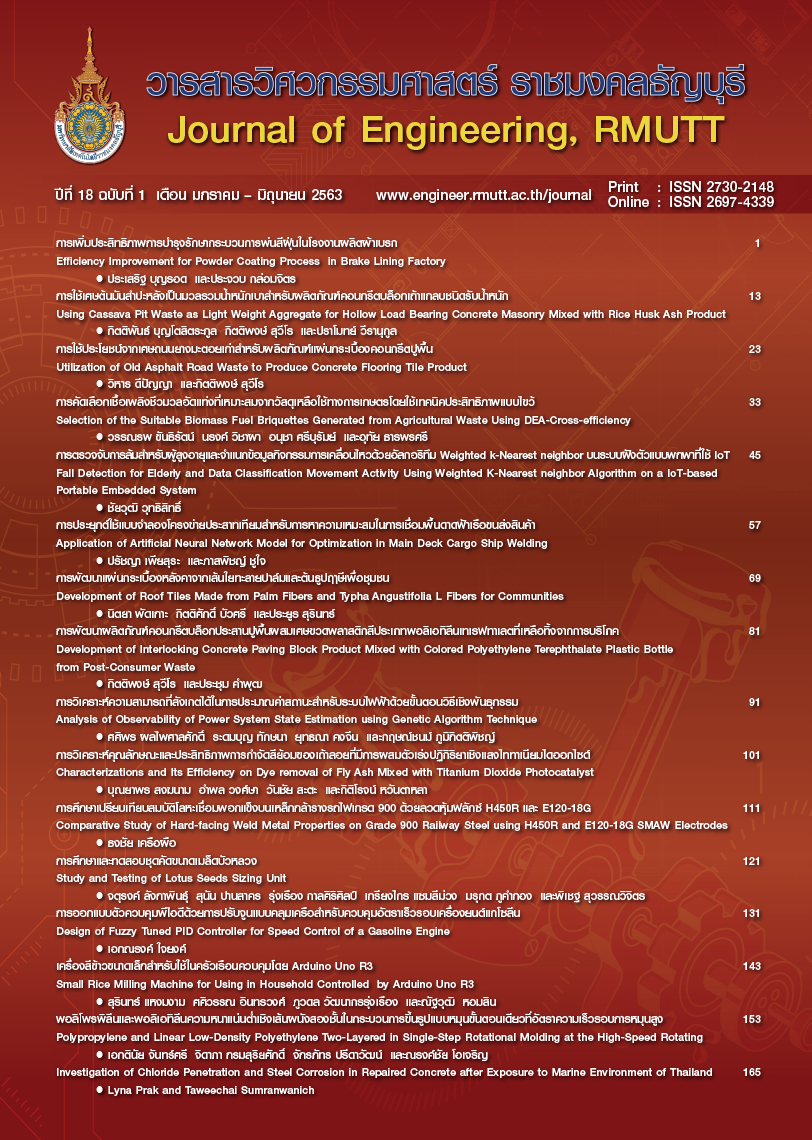Using Cassava Pit Waste as Light Weight Aggregate for Hollow Load Bearing Concrete Masonry Mixed with Rice Husk Ash Product
Main Article Content
Abstract
This research aims to develop the rice husk ash concrete blocks mixed with cassava pit waste. The mixing ratio among Portland cement type1: rice husk ash: quarry dust: water reducer type A: tap water that included 0.7: 0.3: 10: 0.02: 0.6 by weight of admixtures. The quarry dust was replaced by cassava pit waste in 0%, 1%, 3%, 6%, 9% and 12 % by weight of quarry dust. The 6 mixing ratios of concrete block samples were casted same as the ordinary concrete blocks and were tested the properties according to the TIS.57-1990 standard. From the results, the best proportion of concrete block mixed with coconut shell ash is 3% replacement of cassava pit waste. The proper ratios of cassava pit waste can decrease the density or weight and increase the thermal insulation of concrete blocks. However, the over amounts of cassava pit waste can increase the water absorption and decrease the compressive strength properties of concrete blocks.
Article Details
The manuscript, information, content, picture and so forth which were published on Frontiers in engineering innovation research has been a copyright of this journal only. There is not allow anyone or any organize to duplicate all content or some document for unethical publication.
References
Choosit P, Kudngaongarm P, Suweero K.Particle boards made from cassava pit wastes mixed with cement. Journal of Community Development and Life Quality. 2016; 4(3): 339-49. (in Thai)
Weeranukul P, Suweero K. Development of cement boards from coconut shell ash for energy and environment conservation. KKU Engineering Journal.2016; 43(S1): 173-75. (in Thai)
Jindaprasert P, Jaturapitakkul C. Cement,pozzolan, and concrete. 7th ed.Bangkok: ACI Partners with Thailand Concrete Association; 2012. (in Thai)
Thai Industrial Standards Institute (TISI).Thai industrial standard no.5 7-1990:hollow load-bearing concrete masonry units. Bangkok: Thai Industrial Standards Institute; 1990. (in Thai)
Weeranukul P, Suweero K, Weeranukul I.Utilization of vesicular basalt fragment as aggregate in cement board for knockdown building wall. Journal of Engineering, RMUTT. 2019; 17(1): 15-24.(in Thai)
Faherty KF, Williamson TG. Wood engineering and construction handbook. 2nd ed.New York: McGraw-Hill, Inc.; 1995.
Weeranukul P, Suweero K, Weeranukul I.Coconut coir ceiling board product with thermal insulation property. Journal of Engineering, RMUTT. 2018; 16(2): 129-38.(in Thai)
Bledzki AK, Gassan J. Composites reinforced with cellulose based fibers. Progress in Polymer Science. 1999; 24: 221-74.
American Society for Testing and Materials(ASTM). Standard test method for steady-state heat flux measurements and thermal transmission properties by means of the guarded-hot-plate apparatus ( ASTM C177) . Philadelphia:ASTM International; 2010.
Pakunworakij T, Puthipiroj P, Oonjittichai W,Tisavipat P. Thermal resistance efficiency of building insulation material from agricultural waste. Journal of Architectural/Planning Research and Studies. 2006;3(4): 119-26. (in Thai)


